Katalogisierung
Pfad in Koha: Mehr > Administration > Globale Systemparameter > Katalogisierung
anzeigen
AcquisitionDetails
Fragt: ___ Erwerbungsdetails in der Detailansicht des Titels.
Voreingestellt: Zeige
Werte:
Nicht zeigen
Zeige
Beschreibung:
Dieser Systemparameter steuert, ob in der Titeldetailansicht in der Dienstoberfläche ein Reiter mit Erwerbungsinformationen angezeigt wird. Dieser Reiter enthält Links zu Erwerbungsinformationen, die im Erwerbungsmodul gespeichert sind.

hide_marc
Fragt: ___ MARC-Feldnummern, Unterfeldcodes und Indikatoren in der MARC-Ansicht.
Voreingestellt: Zeige
Werte:
Nicht zeigen
Zeige
Beschreibung:
Mit diesem Systemparameter können Sie die MARC-Tag-Nummern und -Indikatoren in der Dienstoberflächen- und in der OPAC-MARC-Ansicht ein- bzw. ausblenden.
Bei „Zeige“ sind MARC-Feldnummern und Indikatoren in der MARC-Ansicht der bibliografischen Datensätze zu sehen.
MARC-Ansicht der Dienstoberfläche:

MARC-Ansicht im OPAC:
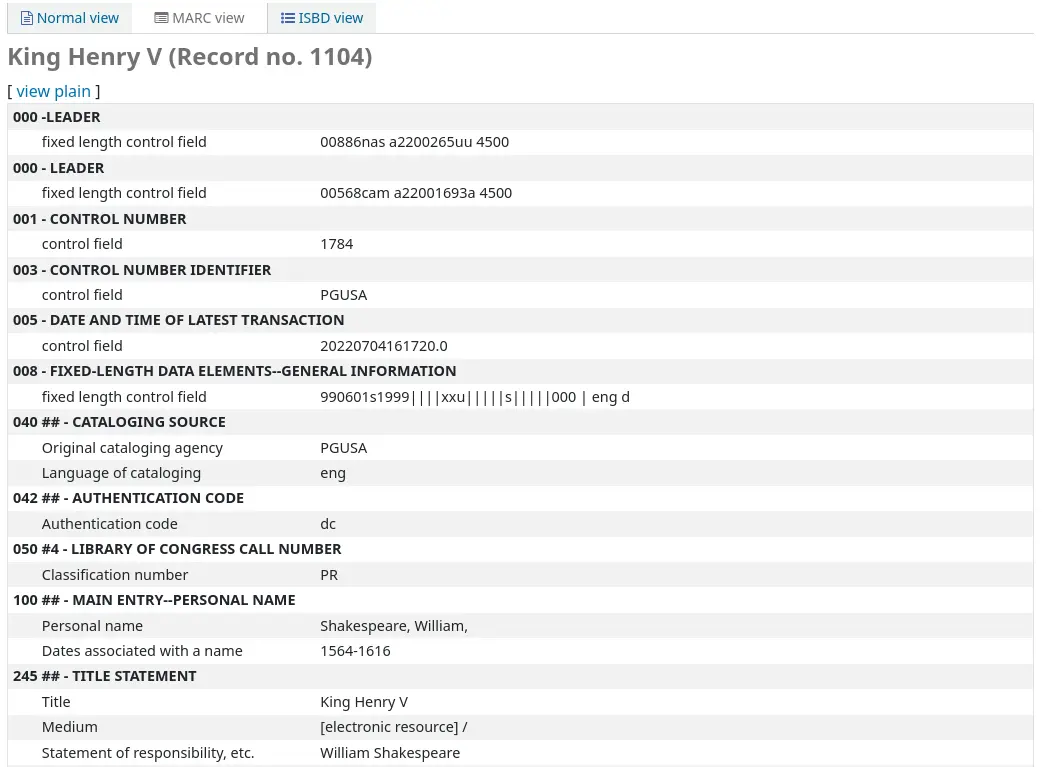
Bei „verberge“ wird in der MARC-Ansicht eines bibliografischen Datensatzes nur der Feldname angezeigt.
MARC-Ansicht der Dienstoberfläche:

MARC-Ansicht im OPAC:
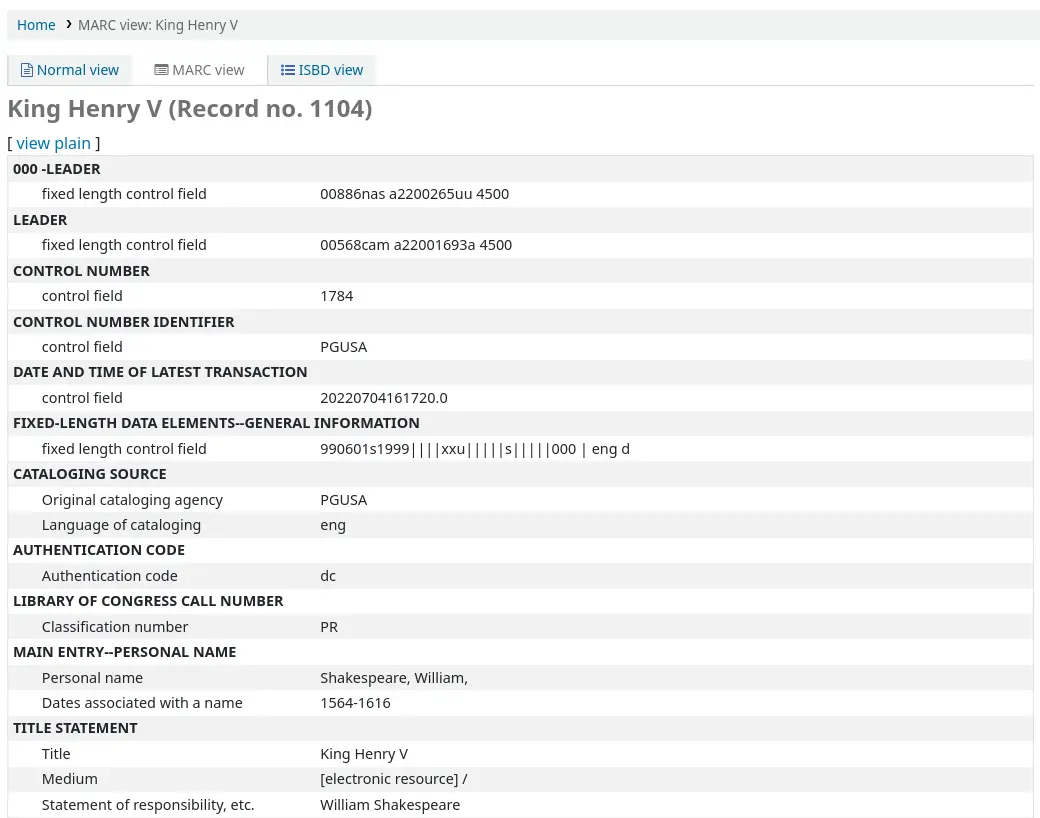
Bemerkung
Entgegen der Beschreibung sind Codes der Unterfelder von diesem Systemparameter nicht betroffen.
Bemerkung
Der Systeparameter wirkt sich nur auf die Anzeige der bibliografischen Datensätze aus.
IntranetBiblioDefaultView
Voreinstellung: ISBD-Ansicht
Fragt: Voreingestellt, zeige Titeldaten in ___
Werte:
ISBD-Ansicht – zeigt Datensätze in der Dienstoberfläche im alten Kartenkatalog-Format an
Für weitere Informationen siehe den Parameter ISBD
Gelabelte MARC-Ansicht – zeigt Datensätze in der Dienstoberfläche im MARC-Format mit Textlabeln als Erklärung der verschiedenen Felder an
MARC-Ansicht – zeigt Datensätze in der Dienstoberfläche im MARC-Format an
normalen Ansicht – Detailanzeige in der Dienstoberfläche (einfache Anzeige)
Beschreibung:
Diese Einstellung legt die Anzeige von bibliografischen Sätzen bei der Katalogsuche in der Dienstoberfläche fest. Die Einstellung hat keinen Einfluss auf die Anzeige im OPAC, welche in den OPAC-Einstellungen unter BiblioDefaultView konfiguriert wird. Die hiesige Einstellung bestimmt, mit welcher Ansicht der Satz als erstes angezeigt wird. Die MARC- und ISBD-Anzeigemöglichkeiten können weiterhin in der Seitenleiste angeklickt werden.
ISBD
Voreinstellung: Siehe ISBD view configuration <https://wiki.koha-community.org/wiki/ISBD_view_configuration> im Wiki.
Fragt: Verwende in der Dienstoberfläche folgende ISBD-Vorlage:
Beschreibung:
Hier wird eingestellt, wie die ISBD-Informationen in der Dienstoberfläche angezeigt werden. Die aufgelisteten Elemente können neu angeordnet werden, um unterschiedliche ISBD-Anzeigen zu erhalten. ISBD, die „International Standard Bibliographic Description“, wurde erstmals 1969 durch IFLA (International Federation of Library Associations) eingeführt, um Richtlinien für die Formalerschließung festzulegen. Der Zweck der ISBD ist, den internationalen Austausch bibliografischer Daten für verschiedene Materialien zu unterstützen.
LabelMARCView
Voreingestellt: Mache nicht
Fragt: ___ wiederholter Felder zu einem Eintrag in der Anzeige.
Werte:
Zusammenfassen – fasst alle identischen Tag-Nummern unter einer Überschrift in der MARC-Ansicht im OPAC und in der Dienstoberfläche zusammen
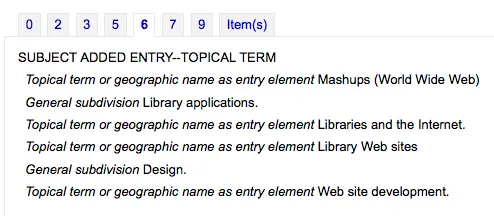
Keine Zusammenfassung – listet alle Tags in der MARC-Ansicht im OPAC und in der Dienstoberfläche einzeln auf
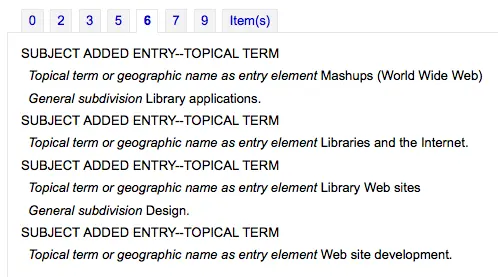
MARCFieldDocURL
Voreinstellung: Leer
Fragt: Verwende ___ als URL für die Dokumentation der MARC-Felder. Mögliche Platzhalter sind {MARC} (MARC-Format, z.B. „MARC21“ oder „UNIMARC“), {FIELD} (Feldnummer, z.B. „000“ oder „048“), {LANG} (Sprache, z.B. „en“ oder „de-DE“). Wenn frei gelassen, dann wird die Dokumentation unter http://loc.gov (MARC21) oder http://archive.ifla.org (UNIMARC) verwendet. Zum Beispiel: http://fielddoc.example.com/?marc={MARC}&field={FIELD}&language={LANG}
Beschreibung:
Mit diesem Systemparameter können Sie die Quelle der MARC-Dokumentation auswählen, die über das „?“ neben den MARC-Feldern aufgerufen werden kann.
MergeReportFields
Asks: Display the following fields for deleted records after merge: ___
Beschreibung:
When merging records together you can receive a report of the merge process once it’s done. This system preference lets you set the default values for this report.
Beispiel: „001,245ab,600“ zeigt:
Wert aus 001
Unterfelder a und b von Feld 245
Alle Unterfelder von 600
NotesToHide
Fragt: Zeige diese ___ Notizfelder nicht im Reiter „Titelfußnoten“ (OPAC-Datensatzdetails) und im Reiter „Beschreibung“ (Dienstoberfläche-Datensatzdetails) an.
Beschreibung:
Mit diesem Systemparameter können Sie festlegen welche der Fußnotenfelder in der Detailansicht in den Reitern „Titelinformationen“ (OPAC) und „Beschreibung“ (Dienstoberfläche) ausgeblendet werden. Geben Sie zum Beispiel 504, 590 ein, um die lokale Fußnote und die bibliografische Fußnote in MARC21 auszublenden.
OpacSuppression, OpacSuppressionByIPRange, OpacSuppressionRedirect
OpacSuppression
Fragt: ___ Titel, die als im OPAC unterdrückt markiert wurden, aus der Trefferliste im OPAC.
Standardwert: Nicht verbergen
Werte:
Nicht verbergen
Zeigt Titel in der Trefferliste im OPAC an, auch wenn sie als unterdrückt markiert sind
Verbergen
Zeigt in der Trefferliste im OPAC keine Titel an, die als unterdrückt markiert sind
Beschreibung:
Dieser Systemparameter steuert das Ausblenden von bibliographischen Einträgen im OPAC. Geben Sie „1“ in das Feld ein, das dem Unterdrückungsindex (942$n in MARC21, kein offizielles Feld in UNIMARC) in jedem bibliographischen Datensatz zugeordnet ist, den Sie aus dem OPAC ausblenden möchten. Der Indexer verbirgt den Datensatz dann von der Anzeige im OPAC, zeigt ihn aber weiterhin in der Dienstoberfläche an.
Bemerkung
Für das MARC21-Feld 942$n (oder das entsprechende UNIMARC-Feld) sollte ein Normierter Wert definiert sein, um Fehler zu vermeiden. Sie können die Kategorie YES_NO für Normierte Werte verwenden oder eine neue Kategorie mit dem Titel SUPPRESS erstellen, z. B. mit den Werten 0 und 1 für (nicht) unterdrücken.
Warnung
Wenn der Parameter auf „Verberge“ eingestellt und für das Feld 942$n 1 eingetragen ist, wird der gesamte bibliographische Datensatz ausgeblendet, nicht nur ein Exemplar.
Bemerkung
Verborgene Datensätze werden in der Dienstoberfläche mit einem Hinweis versehen, dass sie im OPAC nicht mehr angezeigt werden.

Wenn Sie wünschen, kann dieser Hinweis über den Parameter IntranetUserCSS gestaltet werden, um ihn deutlich hervorzuheben.

Für das obige Beispiel wurde IntranetUserCSS das folgende Snippet hinzugefügt
.suppressed_opac {
font-size: larger;
color: red;
}
OpacSuppressionByIPRange
Fragt: Unterdrückung beschränken auf IP-Adressen außerhalb des folgenden IP-Adressbereichs ___ (Frei lassen, wenn nicht verwendet. Geben Sie einen Bereich in der Form 192.168. an.)
Beschreibung:
Wenn Sie die Unterdrückung weiter kontrollieren möchten, können Sie einen IP-Adressbereich festlegen, in dem unterdrückte Elemente weiterhin angezeigt werden. Definieren Sie einen Bereich wie 192.168.. Wenn Sie die Unterdrückung nicht auf diese Weise einschränken wollen, lassen Sie das IP-Feld leer.
OpacSuppressionRedirect
Fragt: Detailanzeige des OPAC bei unterdrückten Titeln umleiten zu ___
Werte:
die 404-Fehlerseite (‚Nicht gefunden‘).
eine Erklärungsseite (‚Dieser Datensatz ist gesperrt‘).
Standard: Erklärungsseite („Dieser Titel ist gesperrt“)
Beschreibung:
Mit diesem Systemparameter können Sie festlegen, was die Benutzer*innen im OPAC sehen, wenn ein Datensatz unterdrückt ist. Sie können dem/der Benutzer*in entweder eine 404-Fehlerseite oder eine erklärende Seite anzeigen, wenn er versucht, einen unterdrückten Datensatz zu sehen. Sie können die Nachricht der Erklärungsseite mit der OpacSuppressionMessage-Anzeigeseite im Werkzeug HTML-Anpassungen ändern.
OpacSuppressionMessage
Achtung
Dieser Systemparameter existiert nicht mehr ab Version 23.11. Er befindet sich jetzt unter HTML-Anpassungen.
Fragt: Zeige die folgende Mitteilung auf der Weiterleitungsseite für im OPAC unterdrückte Titelsätze: ___.
Beschreibung:
Wenn Sie sich dafür entschieden haben, eine erklärende Seite anzuzeigen, wenn ein*e Benutzer*in versucht, auf einen unterdrückten bibliografischen Datensatz zuzugreifen, können Sie die Meldung mit HTML anpassen.
ShowComponentRecords, MaxComponentRecords, ComponentSortField, und ComponentSortOrder
Diese Einstellungen legen fest, ob untergeordnete Datensätze oder Komponentendatensätze auf der Detailseite des Host-Datensatzes angezeigt werden oder nicht.
Dies ist besonders nützlich für die Katalogisierung von Musik, kann aber in jeder Situation verwendet werden, in der es einen Host-Datensatz gibt, z. B. bei der Katalogisierung von Zeitschriften oder Medienkombinationen.
ShowComponentRecords
Fragt: Zeige eine Liste der untergeordneten Datensätze, die über das Feld 773 verknüpft sind, ___ Seiten der Detailansicht.
Standard: nein
Werte:
sowohl Dienstoberfläche als auch OPAC
keine
OPAC
Dienstoberfläche
Beschreibung:
Dies ist der Hauptschalter für die Anzeige der Komponentensätze.
Bei „keine“ ist die Anzeige deaktiviert.
Bei der Einstellung „Dienstoberfläche“ (oder „Dienstoberfläche und OPAC“) werden die Komponentendatensätze auf der Detailseite des Host-Datensatzes in der Dienstoberfläche im Reiter „Komponenten“ angezeigt.
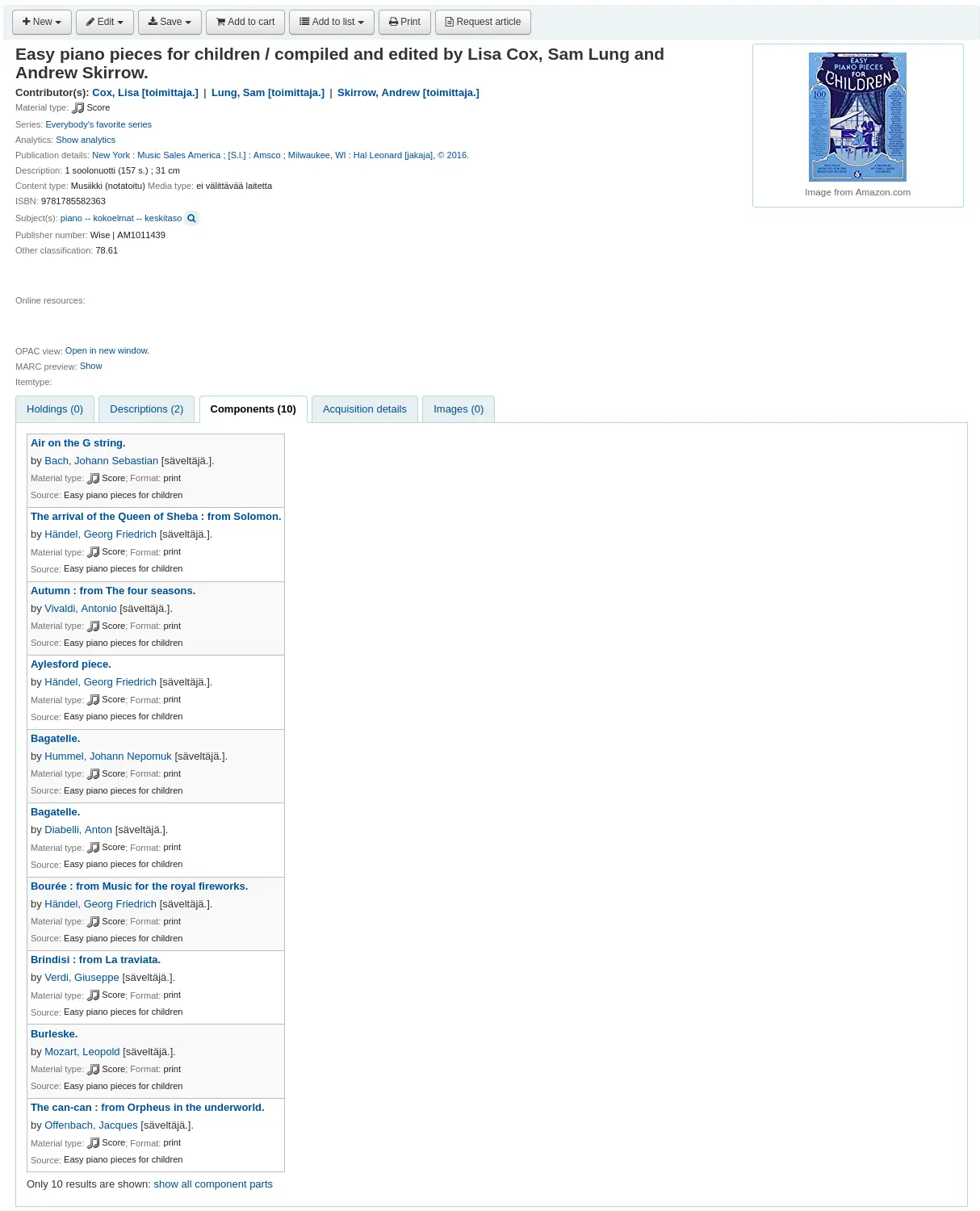
Bei der Einstellung „OPAC“ (oder „Dienstoberfläche und OPAC“) werden die Komponentendatensätze auf der Detailseite des Host-Datensatzes im OPAC im Reiter „Komponenten“ angezeigt.
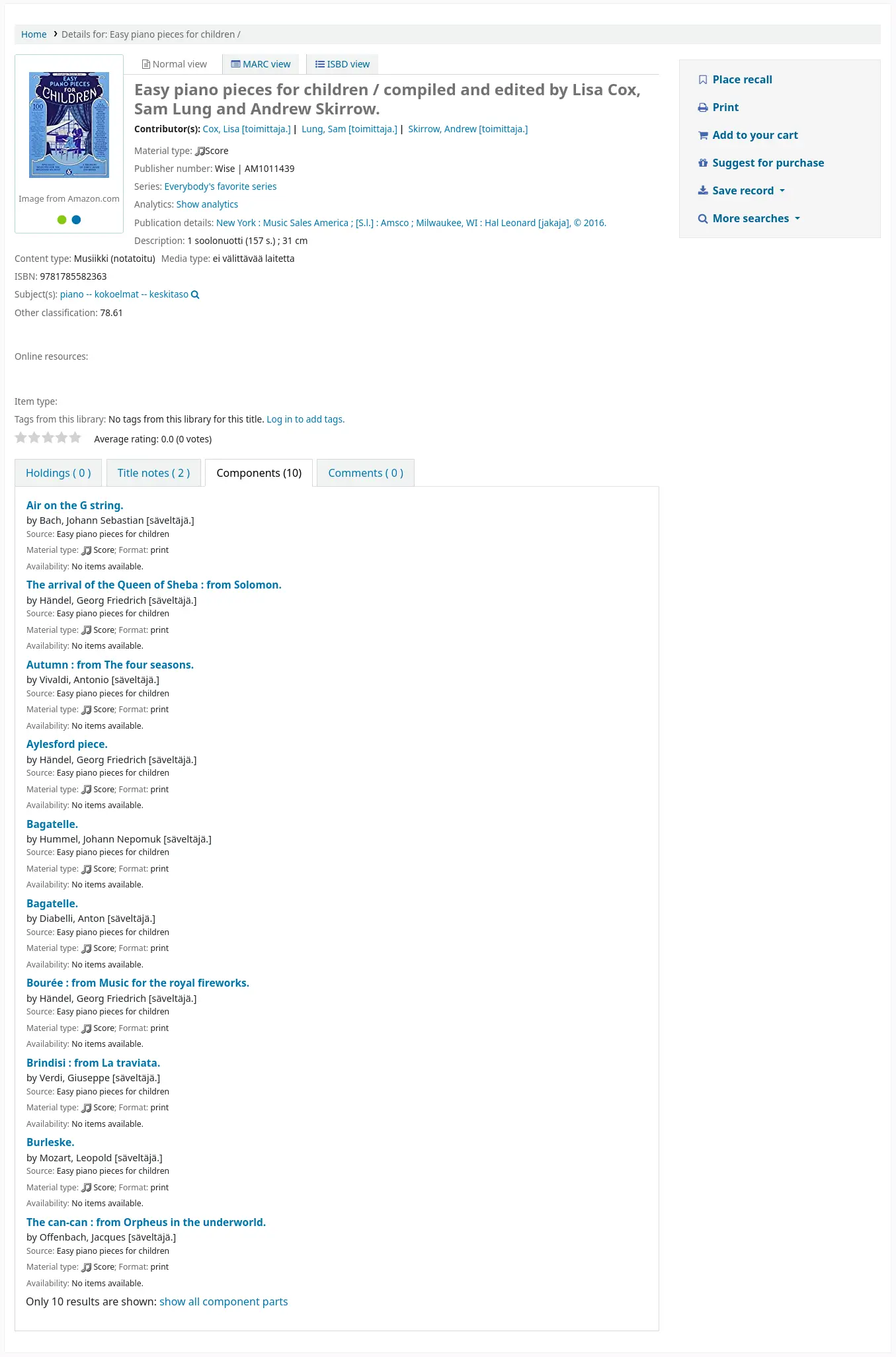
Die anzuzeigenden Komponenten werden anhand der Kontrollnummer (001) des Host-Datensatzes im Unterfeld 773$w des Child-Datensatzes gefunden, unabhängig vom Systemparameter UseControlNumber.
Der Host-Datensatz lautet zum Beispiel
001 4379599 003 FI-BTJ 245 00 ‡aEasy piano pieces for children.
Der Komponenten-Datensatz lautet
001 4401194 003 FI-BTJ 100 1/ ‡aVivaldi, Antonio. 245 10 ‡aAutumn : ‡bfrom The four seasons. 773 0/ ‡w4379599 ‡tEasy piano pieces for children773$w muss die Kontrollnummer des Host-Datensatzes enthalten, mit oder ohne Kontrollnummern-Identifikator.
Beide werden funktionieren
773 0/ ‡w4379599
oder
773 0/ ‡w(FI-BTJ)4379599
Warnung
Diese Funktion funktioniert nur mit MARC21. UNIMARC wird aktuell nicht unterstützt.
Warnung
Der Systemparameter funktioniert nicht mit EasyAnalyticalRecords.
Warnung
Der Systemparameter funktioniert nicht mit UseControlNumber.
MaxComponentRecords
Fragt: Ein Maximum von ___ Datensätze werden angezeigt.
Standard: 300
Beschreibung:
Dieser Systemparameter legt fest, wie viele Komponentendatensätze im Reiter „Komponenten“ sowohl in der Dienstoberfläche als auch im OPAC angezeigt werden.
Wenn der Host-Datensatz mehr Komponenten hat als das System vorgibt, gibt es am Ende einen Link, um die restlichen Datensätze anzuzeigen.
ComponentSortField
Fragt: Standardmäßig werden die Komponentenergebnisse in der Dienstoberfläche nach ___, (ComponentSortOrder) sortiert.
Standard: Titel
Werte:
Erfassungsdatum
Verfasser
biblionumber
Signatur
Erscheinungsjahr
Titel
Beschreibung:
Dieser Systemparameter bestimmt zusammen mit ComponentSortOrder, wie die Komponentendatensätze im Reiter „Komponenten“ sortiert werden.
ComponentSortOrder
Fragt: Sortiere Listen von Teilen nach (ComponentSortField), ___.
Standard: aufsteigend
Werte:
aufsteigend
absteigend
Beschreibung:
Dieser Systemparameter bestimmt zusammen mit ComponentSortField, wie die Komponentendatensätze im Reiter „Komponenten“ sortiert werden.
SeparateHoldings und SeparateHoldingsBranch
SeparateHoldings Standard: Nicht trennen
SeparateHoldingsBranch Standard: Heimatbibliothek
Fragt: ___ die Exemplaranzeige in zwei Reiter, bei welcher der erste Reiter die Exemplare der ___ für die Heimatbibliothek des Benutzers anzeigt. Alle weiteren Exemplare werden dann in einem zweiten Reiter angezeigt.
SeparateHoldings Werte:
Nicht trennen
Teile
SeparateHoldingsBranch Werte:
Bestandsbibliothek
Heimatbibliothek
Beschreibung:
Mit diesem Systemparameter können Sie entscheiden, ob Sie die Exemplaranzeige auf der Detailseite in der Dienstoberfläche in mehrere Reiter aufteilen möchten. In der Standardeinstellung werden alle Bestände in einem Reiter angezeigt.
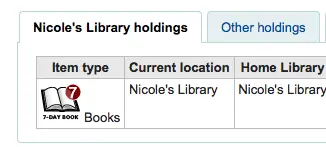
URLLinkText
Standard: Online-Ressource
Fragt: Zeige ___ als Text für Links in den MARC-Titelsätzen und Exemplaren.
Beschreibung:
Wenn für das Feld 856 kein Unterfeld 3, y oder z definiert ist, sagt der OPAC „Klicken Sie hier, um online zuzugreifen“. Wenn Sie möchten, dass in dem Feld etwas anderes steht, geben Sie das in dieses Feld ein.
UseControlNumber
Voreingestellt: Nicht benutzen
Fragt: ___ Datensatzkontrollnummern ($w Unterfelder) und Kontrollnummern (001) für die Verlinkung von bibliographischen Datensätzen.
Werte:
Verwende keine
Wenn Sie auf Links zu Titeln klicken, die in der Detailanzeige neben „Fortsetzungen“ und „Fortgesetzt von“ erscheinen, führt Koha eine Titelsuche durch
Verwenden Sie
Beim Anklicken von Links zu Titeln, die in der Detailanzeige neben „Fortsetzungen“ und „Fortgesetzt von“ erscheinen, führt Koha eine Kontrollnummernsuche (MARC-Feld 001) durch
Wichtig
Sofern Sie nicht 773$w manuell ändern, um Ihren streng definierten bibliographischen Beziehungen zu entsprechen, sollten Sie diese Einstellung auf „Nicht verwenden“ setzen und stattdessen EasyAnalyticalRecords auf „Anzeigen“ setzen
Beschreibung:
Wenn Sie eine Zeitschrift mit dem Namen „Journal of Interesting Things“ haben, die einen separaten Datensatz hat, als sie noch „Transactions of the Interesting Stuff Society“ hieß, können Sie Verknüpfungsfelder hinzufügen, um die Beziehung zwischen den beiden Datensätzen anzugeben. Mit UseControlNumber können Sie Ihre lokalen Zugangsnummern für diese Verknüpfungen verwenden. In MARC21 könnten die entsprechenden Bereiche der beiden Datensätze wie folgt aussehen:
=001 12345 =110 2_$aInteresting Stuff Society. =245 10$aTransactions of the Interesting Stuff Society. =785 00$aInteresting Stuff Society$tJournal of Interesting Things.$w12346 =001 12346 =110 2_$aInteresting Stuff Society. =245 10$aJournal of Interesting Things. =780 00$aInteresting Stuff Society$tTransactions of the Interesting Stuff Society.$w12345
Wenn UseControlNumber auf ‚„Verwenden“ gesetzt ist, werden die 78x-Links die Kontrollnummern im Unterfeld $w verwenden, anstatt eine Titelsuche nach „Journal of Interesting Things“ bzw. „Transactions of the Interesting Stuff Society“ durchzuführen.
Bemerkung
Sie können den Systemparameter autoControlNumber verwenden, um 001 automatisch mit der biblionumber des Datensatzes zu füllen.
Export
BibtexExportAdditionalFields
Fragt: Füge folgende Felder dem BibTeX-Export hinzu
Beschreibung:
Eine Zeile je Tag im Format: BT_TAG: TAG$SUBFIELD (z.B. lccn: 010$a)
Um mehrere MARC-Felder und Unterfelder für einen wiederholbare BibTex-Tag anzugeben, wird folgende Syntax verwendet: BT_TAG: [FELD2$UNTERFELD1, FELD2$UNTERFELD2] (z.B. notes: [501$a, 505$g])
Alle Werte wiederholbarer Felder und Unterfelder werden mit dem angegebenen BibTeX-Tag ausgegeben.
Mit ‚@‘ (mit einfachen Anführungszeichen) als BT_TAG wird der BibTeX-Datensatztyp mit dem Wert aus dem angegebenen Feld überschrieben.
Warnung
Erfordert YAML-Syntax zum Funktionieren
Dies bedeutet
Achten Sie darauf, dass zwischen dem Feldnamen und dem Doppelpunkt KEIN Leerzeichen steht
Stellen Sie sicher, dass zwischen dem Doppelpunkt und dem Wert ein Leerzeichen steht
Wenn es mehrere Werte für dasselbe Feld gibt, setzen Sie sie in eckige Klammern, getrennt durch Komma und Leerzeichen
Achten Sie darauf, dass jedes Paar in einer eigenen Zeile steht
RisExportAdditionalFields
Fragt: Füge die folgenden Felder dem RIS-Export hinzu
Beschreibung:
Eine Zeile je Tag im Format: RIS_TAG: FELD$UNTERFELD (z.B. LC: 010$a)
Um mehrere MARC-Felder und -Unterfelder für ein wiederholbares RIS-Tag anzugeben, verwenden Sie das folgende Format: RIS_TAG: [FELD2$UNTERFELD1, FELD2$UNTERFELD2] (z.B. NT: [501$a, 505$g])
Alle Werte von wiederholten Feldern und Unterfeldern werden mit dem angegebenen RIS-Tag gedruckt.
Mit TY (Datensatzart) als Schlüssel wird der Standard-TY-Wert mit dem Wert des gewählten Felds überschrieben.
Warnung
Erfordert YAML-Syntax zum Funktionieren
Dies bedeutet
Achten Sie darauf, dass zwischen dem Feldnamen und dem Doppelpunkt KEIN Leerzeichen steht
Stellen Sie sicher, dass zwischen dem Doppelpunkt und dem Wert ein Leerzeichen steht
Wenn es mehrere Werte für dasselbe Feld gibt, setzen Sie sie in eckige Klammern, getrennt durch Komma und Leerzeichen
Achten Sie darauf, dass jedes Paar in einer eigenen Zeile steht
Erfordert YAML-Syntax zum Funktionieren
Import
AdditionalFieldsInZ3950ResultSearch
Fragt: Zeige die MARC-Felder/Unterfelder ___ in der Spalte ‚Weitere Felder‘ der Z39.50-Trefferliste (verwende Komma als Trennzeichen, z.B.: „001, 082$ab, 090$ab“).
Beschreibung:
Mit diesem Systemparameter können Sie zusätzliche Felder und Unterfelder für die Anzeige in der Z39.50-Ergebnisliste definieren.
AggressiveMatchOnISBN
Fragt: Wenn beim Import über ISBN abgeglichen wird, ___ mit allen Variationen der ISBNs im importierten Datensatz als Phrase auf die ISBN-Felder der bereits vorhandenen Datensätze zu matchen.
Standard: nicht machen
Werte:
versuche nicht
machen
Beschreibung:
Mit diesem Systemparameter können Sie die ISBN-Abgleichsregel, die beim Bereitstellen von Datensätzen für den Import verwendet wird, aggressiver gestalten. Dies bedeutet, dass der gesamte Text aus dem ISBN-Feld entfernt wird, so dass ein reiner Nummernabgleich möglich ist. Wenn diese Voreinstellung auf „versuche nicht“ gesetzt ist, findet Koha nur dann eine Übereinstimmung, wenn die ISBN-Felder identisch sind.
AggressiveMatchOnISSN
Fragt: Wenn beim Import über ISSN abgeglichen wird, ___ mit allen Variationen der ISSNs im importierten Datensatz als Phrase auf die ISSN-Felder der bereits vorhandenen Datensätze zu matchen.
Standard: nicht machen
Werte:
versuche nicht
machen
Beschreibung:
Mit diesem Systemparameter können Sie die ISSN-Abgleichsregel, die beim Bereitstellen von Datensätzen für den Import verwendet wird, aggressiver gestalten. Dies bedeutet, dass der gesamte Text aus dem ISSN-Feld entfernt wird, so dass ein reiner Nummernabgleich möglich ist. Wenn diese Voreinstellung auf „versuche nicht“ gesetzt ist, findet Koha nur dann eine Übereinstimmung, wenn die ISSN-Felder identisch sind.
MARCOverlayRules
Fragt: ___ MARC-Regeln zum Überlagern von eingehenden Datensätzen, um zu entscheiden, welche Aktion für jedes Feld durchgeführt werden soll.
Voreingestellt: Nicht benutzen
Werte:
Verwende keine
Verwenden Sie
Beschreibung:
Dieser Systemparameter legt fest, ob Mitarbeiter*innen die Record-Overlay-Regeln verwenden können oder nicht.
Die Regeln für die Überlagerung von Datensätzen definieren die MARC-Felder, die beim Importieren und Bearbeiten von Datensätzen über die Dienstoberfläche geschützt (unverändert), überschrieben oder ergänzt werden.
Benutzeroberfläche
advancedMARCeditor
Fragt: ___ die Beschreibungen für Felder und Unterfelder im MARC-Editor.
Voreingestellt: Zeige
Werte:
Nicht zeigen
Zeige
Beschreibung:
Dieser Systemparameter legt fest, ob MARC-Feldnamen bei der Bearbeitung oder Erstellung von MARC-Datensätzen angezeigt werden sollen oder nicht.
Bei der Einstellung „Zeige“ erscheinen die Feld- und Unterfeldnamen neben den Feld- und Unterfeldnummern und -codes.
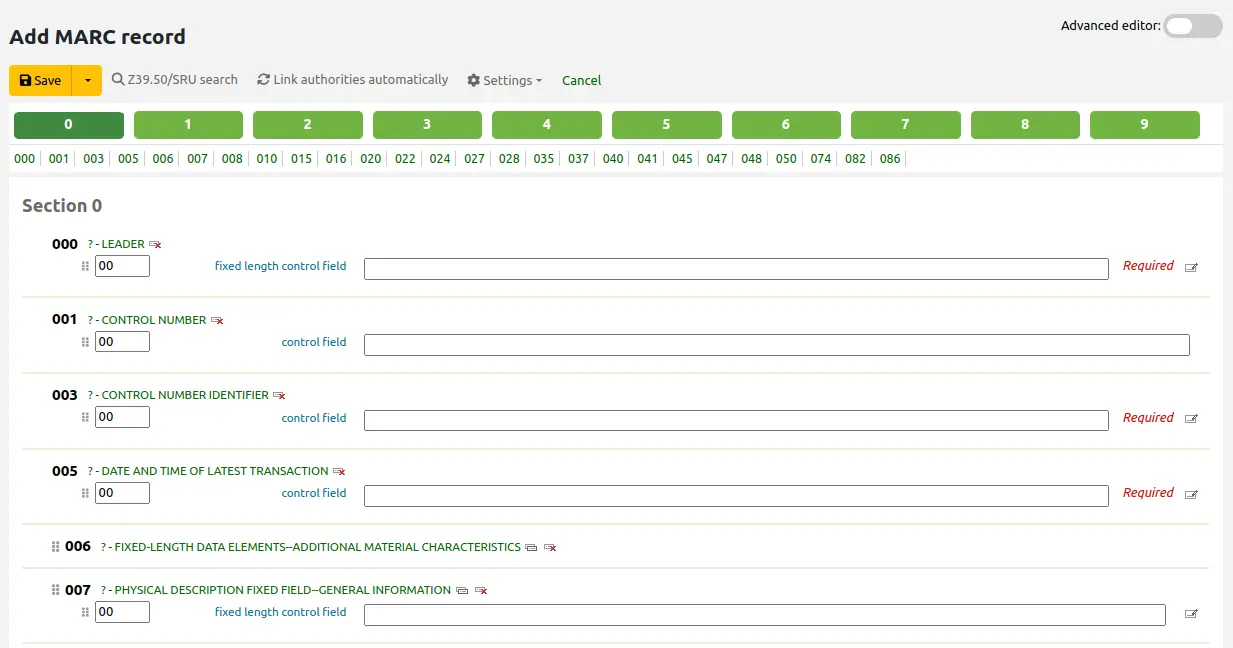
Bei der Einstellung „Verberge“ werden nur die Feldnummern und Unterfeldcodes angezeigt.
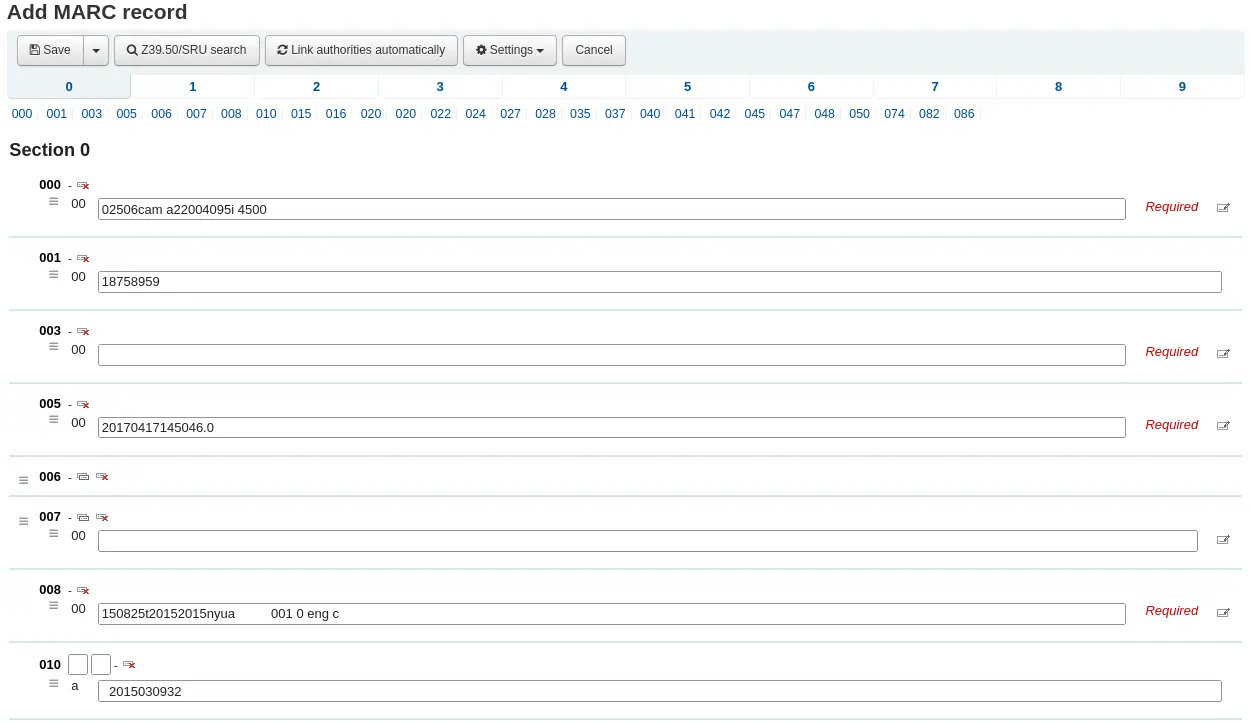
CatalogConcerns
Fragt: ___ Mitarbeitenden, Probleme mit Katalog-Datensätzen zu melden.
Werte:
Zulassen
Nicht zulassen
Voreingestellt: Nicht zulassen
Beschreibung:
Dieser Systemparameter wird verwendet, um die Problemberichtsfunktion in der Dienstoberfläche zu aktivieren.
Wenn die Option „Zulassen“ aktiviert ist, können die Mitarbeiter*innen Tickets für Anliegen erstellen.
Siehe auch:
CatalogerEmails
Fragt: Verwende ___ als E-Mail-Adresse für die Meldung von Katalogproblemen.
Standard: leer
Beschreibung:
Mit diesem Systemparameter wird festgelegt, an welche E-Mail-Adresse neue Katalogprobleme gesendet werden sollen.
Sie können mehrere Email-Adressen eingeben, indem Sie sie durch Kommata trennen.
Bleibt dieses Feld leer, wird keine Email verschickt.
Die gesendete E-Mail ist die TICKET_NOTIFY-Benachrichtigung, die im Werkzeug Benachrichtigungen & Quittungen angepasst werden kann.
Siehe auch:
DefaultClassificationSource
Standard: Dewey-Dezimal-System
Fragt: Verwende ___ als voreingestellte Klassifikation.
Werte:
ANSCR (Tonaufnahmen)
Dewey Dezimalklassifikation
Klassifikation der Library of Congress
Andere/Generische Klassifikation
SuDOC-Klassifikation (U.S. GPO)
Universelle Dezimalklassifikation
Hinweis
Wenn Sie unter Administration > Klassifikationskonfiguration >Klassifikationsquellen eine weitere Klassifikation hinzufügen, wird diese ebenfalls in dieser Liste angezeigt.
DefaultSaveRecordFileID
Wenn eine MARC/MARCXML-Datei im erweiterten Katalogisierungseditor gespeichert oder von der Detailansicht aus in der Dienstoberfläche exportiert wird, verwende die ___ im Dateinamen.
Standard: Datensatzkontrollnummer
Werte:
Datensatzkontrollnummer
Kontrollnummer
Beschreibung:
Dieser Systemparameter bestimmt den Standard-Dateinamen, der beim Herunterladen eines MARC-Datensatzes verwendet wird.
Wenn Sie „Titelsatznummer“ wählen, erhalten Sie einen Dateinamen wie bib-123456.mrc, wobei 123456 die biblionumber ist.
Wenn Sie „Kontrollnummer“ wählen, erhalten Sie einen Dateinamen wie record-123456.mrc, wobei 123456 die Kontrollnummer des Datensatzes ist (in MARC21 ist dies das Feld 001).
EasyAnalyticalRecords
Fragt: ___ die Funktion zur einfachen Erstellung von Teil-Ganzes-Beziehungen zwischen Datensätzen.
Voreingestellt: Nicht zeigen
Werte:
Nicht zeigen
Zeige
Beschreibung:
Ein analytischer Eintrag in einem Katalog ist ein Eintrag, der einen Teil eines größeren Werkes beschreibt, das auch im Katalog beschrieben wird. In der bibliografischen Katalogisierung können analytische Einträge für Kapitel in Büchern oder Sonderheften von Artikeln in Zeitschriften vorgenommen werden. In der archivischen Katalogisierung können analytische Einträge für Serien oder Exemplare innerhalb einer Sammlung gemacht werden. Diese Funktion in Koha ermöglicht eine einfache Verknüpfung von analytischen Einträgen mit den Host-Datensätzen, und dieser Systemparameter fügt mehrere neue Menüoptionen zu den Katalogisierungs-Detailseiten der Dienstoberfläche hinzu, um dies zu ermöglichen.
Choosing ‚Don’t show‘ will result in the linked item record from the host record not displaying as the analytic’s item in the catalog details display.
Choosing ‚Show‘ will result in the linked item record from the host record displaying as the analytic’s item in the catalog details display.
Warnung
Der Systemparameter ‚EasyAnalyticalRecords‘ ist gesetzt, aber ‚UseControlNumber‘ steht auf ‚Verwenden‘. Setzen Sie den Systemparameter UseControlNumber auf ‚Nicht verwenden‘, da sonst die Links für ‚Unselbständige Werke‘ (‚Zeige unselbstständige Werke‘) in der Dienstoberfläche und im OPAC nicht funktionieren.
EnableAdvancedCatalogingEditor
Fragt: ___ das erweiterte Katalogisierungsmodul.
Werte:
Nicht aktivieren
Aktivieren
Voreingestellt: Nicht aktivieren
Beschreibung:
Mit diesem Systemparameter können Sie zwischen einem Basis-Editor und einem erweiterten Editor für das Katalogisieren wählen.
Bemerkung
Diese Funktion schließt aktuell keinen Support für UNIMARC-Felder ein.
Datensatzstruktur
AlternateHoldingsField und AlternateHoldingsSeparator
Fragt: Zeige das MARC-Unterfeld ___ als Bestandsinformation bei Datensätzen, die keine Exemplare haben, wobei die Unterfelder durch ___ getrennt sind.
Beschreibung:
Manchmal migrieren Bibliotheken zu Koha mit ihren Bestandsinformationen im Feld 852 (OCLC-Bestandsinformationsfeld) und entscheiden sich dafür, diese Informationen nicht in das Feld 952 (Koha-Bestandsinformationsfeld) zu übertragen, weil sie nicht vorhaben, diese Exemplare zu verleihen. Für diese Bibliotheken oder andere Bibliotheken, die Daten in den 852-Feldern ihrer Datensätze haben, die sie anzeigen möchten, können Sie mit diesen Parametern wählen, ob Sie Bestandsinformationen aus einem anderen Feld als dem 952-Feld anzeigen möchten. Die Voreinstellung AlternateHoldingsField kann mehrere Unterfelder enthalten, in denen gesucht werden soll; zum Beispiel würde 852abhi in den 852-Unterfeldern a, b, h und i suchen.
Wenn für AlternateHoldingsField 852abhi und für AlternateHoldingsSeparator ein Leerzeichen eingetragen ist, würden die Bestände wie folgt aussehen:

ApplyFrameworkDefaults
Fragt: Verwende die Standardwerte aus dem Framework, ___
Standard: wenn ein neuer Datensatz angelegt wird
Werte:
[Alle auswählen]
wenn ein neuer Datensatz angelegt wird
wenn das Framework bei einem vorhandenen Datensatz geändert wird
wenn ein Datensatz als Kopie eines vorhandenen angelegt wird
wenn ein Datensatz über Z39.50 importiert wird
Beschreibung:
Dieser Systemparameter wird verwendet, um zu bestimmen, wann die Standardwerte, wie sie in der MARC bibliographischen Frameworks oder der Normdaten-Frameworks definiert sind.
Wenn Sie andere Werte als für einen neuen Datensatz wählen, werden die Standardwerte nur ausgefüllt, wenn die Felder leer sind. Die vorhandenen Informationen werden nicht überschrieben.
autoBarcode
Standard: in der Form <branchcode>JJMM0001 generiert
Fragen: Barcodes werden ___
Werte:
in der Form <branchcode>jjjjmm0001 generiert
in der Form <year>-0001, <year>-0002 generiert
in der Form 1, 2, 3 generiert
inkrementelle EAN-13-Barcodes
nicht automatisch generiert
Beschreibung:
Diese Einstellung ist für Bibliotheken gedacht, die Barcodes aus Koha heraus generieren möchten (im Gegensatz zum Einscannen von vorgedruckten Barcodes oder der manuellen Zuweisung von Barcodes). Das Standardverhalten sieht vor, dass beim Anklicken des Barcode-Feldes (952$p in MARC21) der von Ihnen gewählte automatische Barcode eingefügt wird. Wenn Sie möchten, dass nur ein automatischer Barcode eingegeben wird, wenn Sie auf das Plugin (das … rechts neben dem Feld) klicken, können Sie das für dieses Feld verwendete Plugin im Framework ändern. Setzen Sie das Plugin für 952$p (wenn Sie MARC21 oder ein entsprechendes Feld verwenden, das in Ihrem lokalen MARC-Format auf items.barcode abgebildet ist) für Ihre Frameworks auf barcode_manual.pl anstelle von barcode.pl. Weitere Informationen zur Bearbeitung von Frameworks finden Sie im Bereich MARC bibliographische Frameworks in diesem Handbuch.
autoControlNumber
Fragt: Kontrollnummer (001) wird ___.
Standard: nicht automatisch generiert
Werte:
mit der Titelsatznummer (biblionumber) belegt
nicht automatisch generiert
Beschreibung:
Der Systemparameter wird genutzt, um automatisch eine Kontrollnummer in MARC-Feld 001 zu erzeugen.
Koha erzeugt standardmäßig keine Kontrollnummer für Datensätze.
Bei der Einstellung „mit der Titelsatznummer (biblionumber) belegt“ wird die Kontrollnummer mit der biblionumber gefüllt, sobald der Datensatz gespeichert wird.
Bestehende Datensätze, die bereits einen Wert in 001 haben, sind davon nicht betroffen. Der bestehende Wert wird beibehalten.
Wenn ein bestehender Datensatz keinen Wert in 001 hat, wird die biblionumber hinzugefügt.
Wenn Sie einen Datensatz duplizieren, wird 001 nicht in den neuen Datensatz kopiert. Die biblionumber wird beim Speichern des neuen Datensatzes zu 001 hinzugefügt.
ContentWarningField
Fragt: Verwende das MARC-Feld ___, um Inhaltswarnungen zu speichern.
Voreingestellt: Keine
Beschreibung:
Dieser Systemparameter wird verwendet, um das MARC-Feld auszuwählen, das verwendet wird, um Inhaltswarnungen zu einem bibliografischen Datensatz hinzuzufügen.
Es wird empfohlen, ein lokales Notizfeld zu verwenden (z. B. 599 in MARC21).
Stellen Sie sicher, dass Sie das Feld im bibliografischen MARC Framework hinzufügen, um es bearbeiten zu können.
Das Unterfeld x wird im OPAC nicht angezeigt. Verwenden Sie es, um nicht-öffentliche Notizen über die Inhaltswarnung hinzuzufügen.
Das Unterfeld u wird als URL für das Feld verwendet. Achten Sie darauf, http(s):// hinzuzufügen. Das Unterfeld a (nicht wiederholbar) wird als Text für die URL verwendet.
Alle anderen Unterfelder werden der Reihe nach angezeigt.
DefaultCountryField008
Standard: Leer wird mit xxu für die USA vorbelegt
Fragt: Vorbelegung des Ländercodes 008 15-17 in MARC21 - Ort der Publikation, Produktion oder Ausführung. ___.
Beschreibung:
Mit diesem Systemparameter können Sie den Ländercode für Ihr Feld MARC21 008 standardmäßig festlegen. Wenn Sie diese Einstellung leer lassen, wird standardmäßig United States (xxu) verwendet. Weitere Werte für diesen Parameter finden Sie hier: „MARC Code List for Countries <http://www.loc.gov/marc/countries/countries_code.html>“.
Hinweis
Dieser Systemparameter hat keine Auswirkung wenn Ihre Datensätze in UNIMARC stehen.
DefaultLanguageField008
Standard: bei fehler Eingabe wir eng genutzt
Fragt: Vorbelegung der Sprache in Feld 008 Position 35-37 der MARC21-Datensätze ___.
Beschreibung:
Mit diesem Systemparameter können Sie die Sprache für Ihr MARC21 008-Feld standardmäßig festlegen. Wenn Sie diese Einstellung leer lassen, wird standardmäßig Englisch (eng) verwendet. Weitere Werte für diese Einstellung finden Sie hier: „MARC Code List for Languages <http://www.loc.gov/marc/languages/language_code.html>“.
Hinweis
Dieser Systemparameter hat keine Auswirkung wenn Ihre Datensätze in UNIMARC stehen.
EnableItemGroups
Version
Vor Version 23.11 von Koha befand sich dieser Systemparameter unter Ausleiheinstellungen > Vormerkungs-Policy.
Fragt: ___ die Funktion für Exemplargruppen, die es erlaubt Exemplare an einem Titelsatz in Gruppen zusammen zu fassen.
Beschreibung:
Dieser Systemparameter aktiviert die Funktion der Exemplargruppen.
Es kann mit EnableItemGroupHolds verwendet werden, um Vormerkungen für Exemplargruppen zu erlauben.
item-level_itypes
Standard: bestimmtes Exemplar
Asks: Use the item type of the ___ as the authoritative item type (for determining circulation and fines rules, for displaying an item type icon on either opac detail or results page, etc).
Werte:
bibliographischer Datensatz
bestimmtes Exemplar
Beschreibung:
Dieser Systemparameter legt fest, ob der Exemplartyp, den Koha für die Ausgabe von Exemplaren verwendet, ein Attribut des bibliografischen Datensatzes oder des Exemplardatensatzes ist. Die meisten Bibliotheken beziehen sich auf den Exemplardatensatz für Exemplartypen. Sie bestimmt auch, ob das Symbol für den Exemplartyp in den OPAC-Suchergebnissen erscheint. Wenn Sie die Einstellung „bibliographischer Datensatz“ gewählt haben, zeigt Koha das Symbol für den Exemplartyp in den Suchergebnissen links neben den Ergebnisinformationen an.
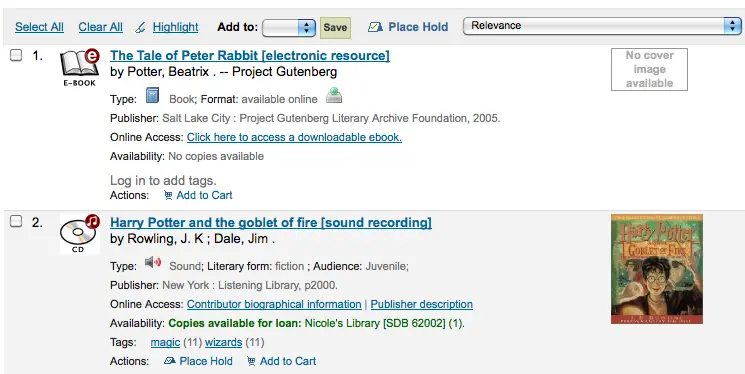
Signatur
Standardwert: 082ab
Fragt: Ordnet das MARC-Unterfeld der Exemplarsignatur zu.
Hinweis
Dies kann mehrere Unterfelder enthalten, in denen gesucht werden soll; zum Beispiel würde 082ab in den 082-Unterfeldern a und b gesucht.
Beschreibung:
Diese Einstellung legt fest, welches MARC-Feld verwendet wird, um die Signatur zu bestimmen, die automatisch in die Exemplardatensätze eingetragen wird (952$o). Der Wert wird durch Angabe des MARC-Feldcodes (050, 082, 090, 852 sind alle in MARC21 gebräuchlich) und der Unterfeldcodes ohne die Trennzeichen ($a, $b wäre ab) festgelegt.
Das Feld kann auch mehrere MARC-Felder in Prioritätsreihenfolge enthalten. Bei 082ab,050ab,080ab,090ab wird z. B. vorrangig in 082ab gesucht, wenn 082 nicht ausgefüllt ist, wird in 050ab gesucht, usw.
Wichtig Wenn Sie mehr als ein MARC-Feld eingeben, trennen Sie diese durch ein Komma, aber setzen Sie keine Leerzeichen nach den Kommas.
Beispiele:
Dewey: 082ab oder 092ab; LOC: 050ab oder 090ab; aus dem Exemplardatensatz: 852hi
MarcFieldForCreatorId, MarcFieldForCreatorName, MarcFieldForModifierId, MarcFieldForModifierName
Fragt: Speichere die Benutzernummer des Erstellers eines Titelsatzes in folgendem MARC-Unterfeld ___ und den Namen des Erstellers in MARC-Unterfeld ___. Speichere den letzten Bearbeiter eines Titelsatzes in folgendem MARC-Unterfeld ___ und den Namen des letzten Bearbeiters in MARC-Unterfeld ___ HINWEIS: Verwenden Sie ein Dollarzeichen zwischen Feld und Unterfeld: 123$a.
Beschreibung:
Mit diesem Systemparameter können Sie festlegen, welche MARC-Unterfelder verwendet werden sollen, um die Details des angemeldeten Benutzers automatisch zu speichern. Sie können Details für den Ersteller des Datensatzes und den letzten Bearbeiter speichern.
marcflavour
Standardwert: MARC21
Fragt: Interpretiere und speichere MARC-Datensätze im Format ___.
Werte:
MARC21
Der Standardstil für die USA, Kanada, Australien, Neuseeland, das Vereinigte Königreich, Deutschland und andere Länder
UNIMARC
Der in Frankreich, Italien, Portugal, Russland und anderen Ländern verwendete Standardstil
Beschreibung:
Dieser Systemparameter definiert den globalen MARC-Stil (MARC21, UNIMARC oder NORMARC), der für die Kodierung verwendet wird.
Wichtig
Das Ändern des Wertes dieser Einstellung führt nicht dazu, dass Ihre Datensätze von einem MARC-Stil in einen anderen umgewandelt werden.
MARCOrgCode
Standard: OSt
Fragt: Verwende den MARC-Organisationscode ___ Vorbelegung in neuen MARC21-Datensätzen (leer = keine Vorbelegung).
Beschreibung:
Der MARC-Organisationscode dient zur Identifizierung von Bibliotheken mit Beständen der Titel und mehr.
Learn more and find your library’s MARC21 code on the MARC Code list for Organizations or in Canada on the Canadian Symbols Directory.
Hinweis
Dieser Systemparameter hat keine Auswirkung wenn Ihre Datensätze in UNIMARC stehen.
NewItemsDefaultLocation
Fragt: Neu katalogisierte Exemplare erhalten den Standort ___ (sollte mit einem Standortcode belegt oder leer, wenn nicht verwendet, sein).
Beschreibung:
So können Sie einen bestimmten Standort für alle neuen Exemplare festlegen.
Stellen Sie sicher, dass Sie Standortcodes aus der Normierten-Werte-Kategorie LOC verwenden
Sie können den Systemparameter UpdateItemLocationOnCheckin oder den Systemparameter UpdateItemLocationOnCheckout zusammen mit dieser verwenden, um den Standort beim Zurückbuchen oder Ausleihen zu aktualisieren.
PrefillItem
Standard: das neue Exemplar wird nicht mit den Werten des zuletzt erstellten Exemplars vorausgefüllt.
Fragt: Wenn ein Exemplar katalogisiert wird, ___
Werte:
das neue Exemplar wird nicht mit den Werten des zuletzt erstellten Exemplars vorausgefüllt.
das neue Exemplar wird mit den Werten des zuletzt erstellten Exemplars vorausgefüllt.
Beschreibung:
Dieser Systemparameter steuert das Verhalten beim Hinzufügen neuer Exemplare. Mit den Optionen hier können Sie wählen, ob Ihr nächstes neues Exemplar mit den Werten vorausgefüllt werden soll, die im zuletzt hinzugefügten Exemplar verwendet wurden, um Zeit bei der Eingabe von Werten zu sparen, oder ob das Exemplarformular komplett leer erscheinen soll. Mit SubfieldsToUseWhenPrefill können Sie gezielt steuern, welche Felder vorausgefüllt werden.
StripWhitespaceChars
Fragt: ___ Leerzeichen am Anfang und Ende (inklusive Leerzeichen, Tabs und Zeilenumbrüche) und Zeilenumbrüche innerhalb von Datenfeldern bei der Katalogisierung von Titel- und Normdaten. Der Leader und die Kontrollfelder sind ausgenommen.
Standardwert: Nicht entfernen
Werte:
Nicht entfernen
Entfernen
Beschreibung:
Manchmal werden beim Kopieren von Daten aus anderen Quellen versehentlich unsichtbare Zeichen eingefügt, die zu Datendiskrepanzen führen können, z. B. bei der automatischen Verknüpfung von Normdaten.
Dieser Systemparameter wird verwendet, um automatisch unerwünschte unsichtbare Zeichen aus Feldern zu entfernen, bei der Katalogisierung bibliographischer Datensätze oder Katalogisierung von Normdaten.
Bei der Einstellung „Entfernen“ werden die folgenden Zeichen automatisch entfernt
Leerzeichen am Anfang des Feldes
Leerzeichen am Ende des Feldes
Tab am Anfang des Feldes
Tab am Ende des Feldes
Zeilenumbruch am Anfang des Feldes
Zeilenumbruch innerhalb des Feldes
Zeilenumbruch am Ende des Feldes
Bemerkung
Nur Datenfelder (Felder mit Unterfeldern) sind von diesem Systemparameter betroffen. Die Leader- und Kontrollfelder sind nicht betroffen, da sie oft Leerzeichen enthalten müssen.
SubfieldsToAllowForRestrictedBatchmod
Anfrage: Definieren Sie eine Liste von Unterfeldern, für die die Bearbeitung erlaubt ist, wenn items_batchmod_restricted permission aktiviert ist, getrennt durch Leerzeichen. ___
Beispiele:
UNIMARC: „995$f 995$h 995$j“
MARC21: „952$a 952$b 952$c“
Beschreibung:
Diese Option erlaubt es, zu bestimmen, welche Felder mit der Stapelbearbeitung für Exemplare bearbeitet werden können, wenn die Berechtigung items_batchmod_restricted gesetzt ist.
Hinweis
Das FA-Framework ist von der Berechtigung ausgeschlossen. Wenn pref leer ist, werden keine Felder eingeschränkt.
SubfieldsToAllowForRestrictedEditing
Fragt: Definieren Sie eine Liste von Unterfeldern, für die die Bearbeitung erlaubt ist, wenn die Berechtigung Edit_items_restricted aktiviert ist, getrennt durch Leerzeichen. ___
Beispiele:
UNIMARC: „995$f 995$h 995$j“
MARC21: „952$a 952$b 952$c“
Beschreibung:
Diese Option erlaubt es, zu bestimmen, welche Felder in der Katalogisierung bearbeitet werden können, wenn die Berechtigung edit_items_restricted gesetzt ist.
Hinweis
Das Fast Add (FA) Framework ist von der Erlaubnis ausgeschlossen. Ist pref leer, werden keine Felder eingeschränkt.
SubfieldsToUseWhenPrefill
Fragt: Definieren Sie eine Liste von Unterfeldern, die von einem katalogisierten Exemplar in das nächste übernommen werden sollen: ___
Wichtig
Trennen Sie die Werte mit einem Leerzeichen.
Beschreibung:
Wenn die Einstellung PrefillItem so eingestellt ist, dass die Werte des zuletzt hinzugefügten Eintrags vorausgefüllt werden, kann diese Einstellung steuern, welche Felder vorausgefüllt werden (und welche nicht). Geben Sie eine durch Leerzeichen getrennte Liste von Feldern ein, die beim Hinzufügen eines neuen Exemplars vorausgefüllt werden sollen.
UNIMARCField100Language
Standardwert: fre
Fragt: Verwende den Sprachcode (ISO 690-2) ___ als Voreinstellung für die Sprache in UNIMARC-Feld 100, wenn ein neuer Datensatz angelegt wird.
UseOCLCEncodingLevels
Fragt: ___ von OCLC-definierte Werte für MARC-Codierungslevel für Leader, Pos. 17 im Katalogisierungsplugin.
Standard: Nicht anzeigen
Werte:
Zeige keine
anzeigen
Beschreibung:
Dieser Systemparameter steuert, ob die OCLC-Werte für Codierungslevel im Leader Value Builder angezeigt werden oder nicht.
Wenn die Option „Anzeigen“ aktiviert ist, werden die zusätzlichen OCLC-Werte im Dropdown-Menü des Leader Value Builders angezeigt.
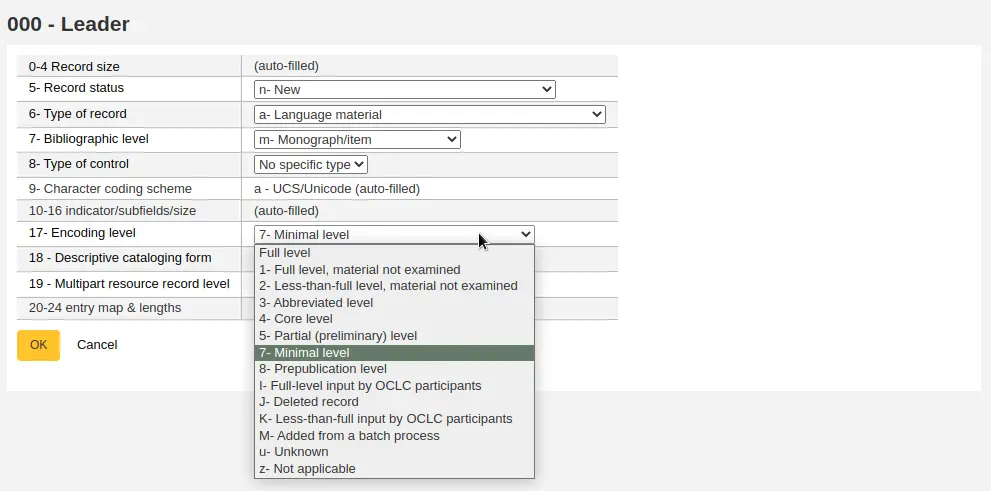
Signaturschilder
SpineLabelAutoPrint
Standard: nicht machen
Fragt: Bei Verwendung des schnellen Signaturdrucks ___ automatisch Druckdialog als Pop-up öffnen.
Werte:
machen
versuche nicht
SpineLabelFormat
Standard: <itemcallnumber><copynumber>
Fragt: gebe folgende Felder auf den schnell-gedruckten Signaturschildern aus: (Geben Sie Spalten aus den Tabellen biblio, biblioitems oder items an, jeweils eingerahmt von < und >.)
SpineLabelShowPrintOnBibDetails
Fragt: ___ Schaltflächen für den Druck von Signaturschildern in der Detailansicht eines Titels.
Voreingestellt: Nicht zeigen
Werte:
Nicht zeigen
Zeige
Beschreibung:
Wenn die Option „Anzeigen“ aktiviert ist, gibt es in der Bestandstabelle in der Dienstoberfläche für jedes Exemplar eine Schaltfläche „Etikett drucken“.

Diese Schaltfläche öffnet das Werkzeug für schnelle Etiketten-Erstellung.